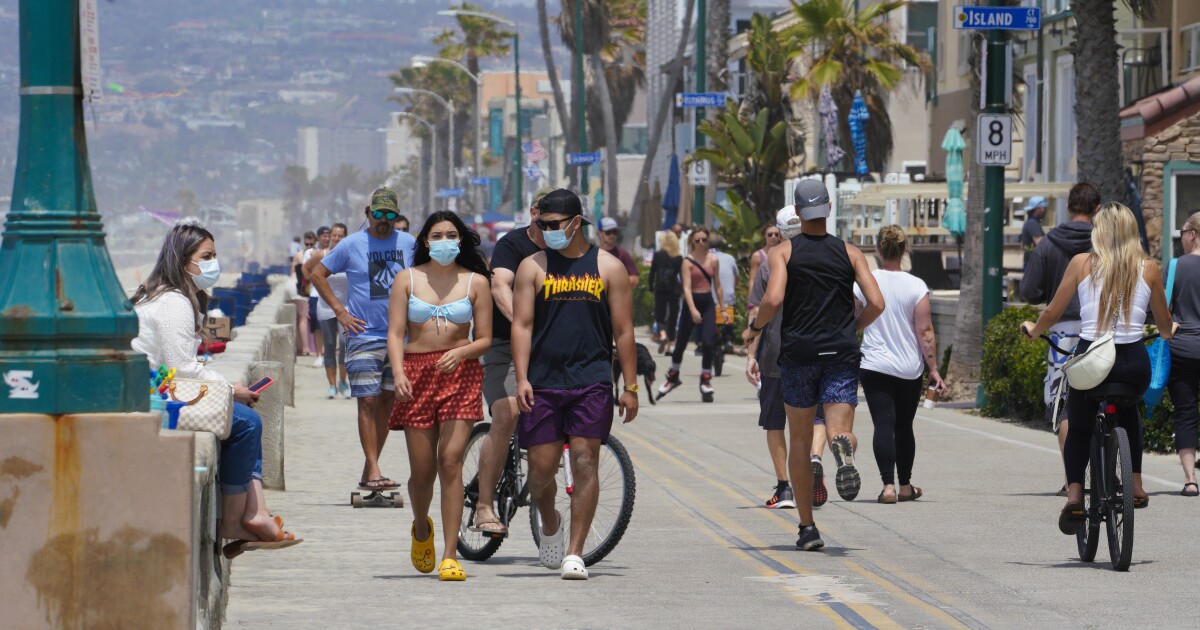
With no local cases yet confirmed, state and local public health officials seem to be taking a wait-and-see approach to Omicron, the new coronavirus with worrisome attributes first detected in South Africa.
With the World Health Organization naming Omicron a “variant of concern” on Thanksgiving day, and the the Biden administration suspending non-citizen entry into the United States from eight African nations effective Monday, efforts are under way to keep the latest coronavirus threat at bay.
The arrival of a new variant from overseas has not yet prompted public talk of stiffening relaxed public health measures.
When the Delta variant was first detected in San Diego County in April, the state’s tier-based reopening system was still in effect and a widespread mask mandate still required face coverings indoors.
The tier system fell away in June and the mask mandate changed dramatically on July 28. While masks are still required in transportation hubs, on planes, in health care settings, homeless shelters and K-12 schools, only the unvaccinated are required to wear face coverings in all indoor locations.
Mask use is currently very variable, with a few organizations requiring universal mask use while others leave it up to individual choice. Vaccination verification seems to be very rare indoors.
Asked Monday whether Californians should expect a change to mask requirements as Omicron arrives, the California Department of Public Health’s only response was a statement issued Sunday. It noted that the state is monitoring the situation and emphasizing that the state’s main response is “doubling down on our vaccination and booster efforts to ensure that all Californians have access to safe, effective and free vaccines that can prevent serious illness and death.”
Individual public health jurisdictions have the ability to be more, but not less, restrictive than the state, but that did not appear to be the direction things were headed in San Diego County Monday.
Asked to delineate the point at which it would change pandemic regulation, the county health department declined to draw any particular line in the sand, saying in a short statement that moves like a more-strict mask mandate need more information on “how easily it (Omicron) spreads and whether it’s more dangerous.”
“There’s no clear line yet without a better understanding of what it means epidemiologically,” the county statement said. “In the meantime, the recommendations for the public — indoor masking, vaccination and good hygiene — stay the same as they do for Delta.”
Those closest to the global effort to spot new variants in the wild and estimate their prevalence and threat level have been calling for greater mask usage, and broader vaccination, for months.
Kristian Andersen, an immunologist and molecular biologist at Scripps Research in San Diego whose lab is at the forefront of the coronavirus genetic analysis effort, noted that preventive efforts have the most power when taken early.
“We need to take action now, no question,” Andersen said in an email. “While it’s currently not prevalent in San Diego, if the early data we have turn out to be consistent more broadly speaking, it’ll be here soon enough and start spreading.”
More robust masks such as the N95 and KN95 types often used by health care workers, he said, are warranted as is more rapid testing.
“Our main aim is to avoid having to resort to lockdowns, whether partial or complete,” he said. “That will likely require action, and early preparation is much better than late reaction.”
UC San Diego evolutionary biologist Joel Wertheim, a scientist whose research has included tracing the early emergence of SARS-CoV-2 in China, agreed.
“Masking is one of the most-effective and underutilized tools we have in stopping the spread of SARS-CoV-2, and I see nothing to suggest it won’t be effective against the Omicron variant,” Wertheim said. “A mask mandate would likely slow its introduction and spread within San Diego County.”
Vaccination, and now booster shots for those whose second shot is at east six months in the past, remains a key way of fighting the virus, though vaccine effectiveness against Omicron is still under study.
The county reported Monday that waits at its vaccination clinics for those without appointments ranged from 90 minutes to two hours. Appointments at county vaccination sites were said to be booked six day in advance. Local health providers, though, did not report similar demand, though Kaiser Permanente said through a spokesperson that it saw an increase in college-aged appointments over the weekend likely among students home for the holidays.
"wait" - Google News
November 30, 2021 at 08:44AM
https://ift.tt/3FZzy1T
As Omicron threat looms, local health care leaders take wait-and-see approach - The San Diego Union-Tribune
"wait" - Google News
https://ift.tt/35qAU4J
https://ift.tt/2Ssyayj
Bagikan Berita Ini














0 Response to "As Omicron threat looms, local health care leaders take wait-and-see approach - The San Diego Union-Tribune"
Post a Comment